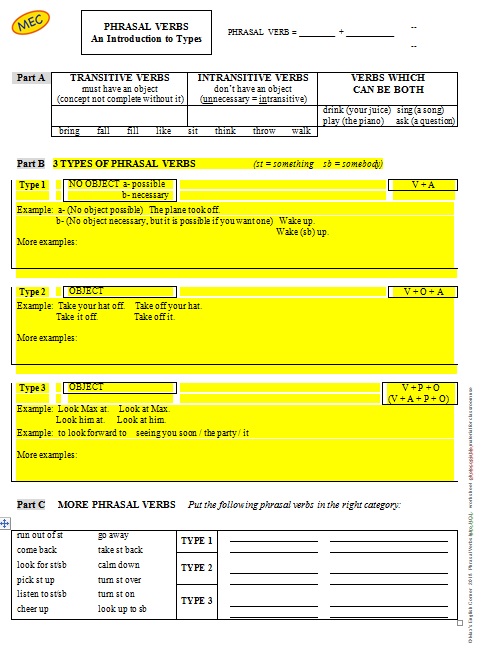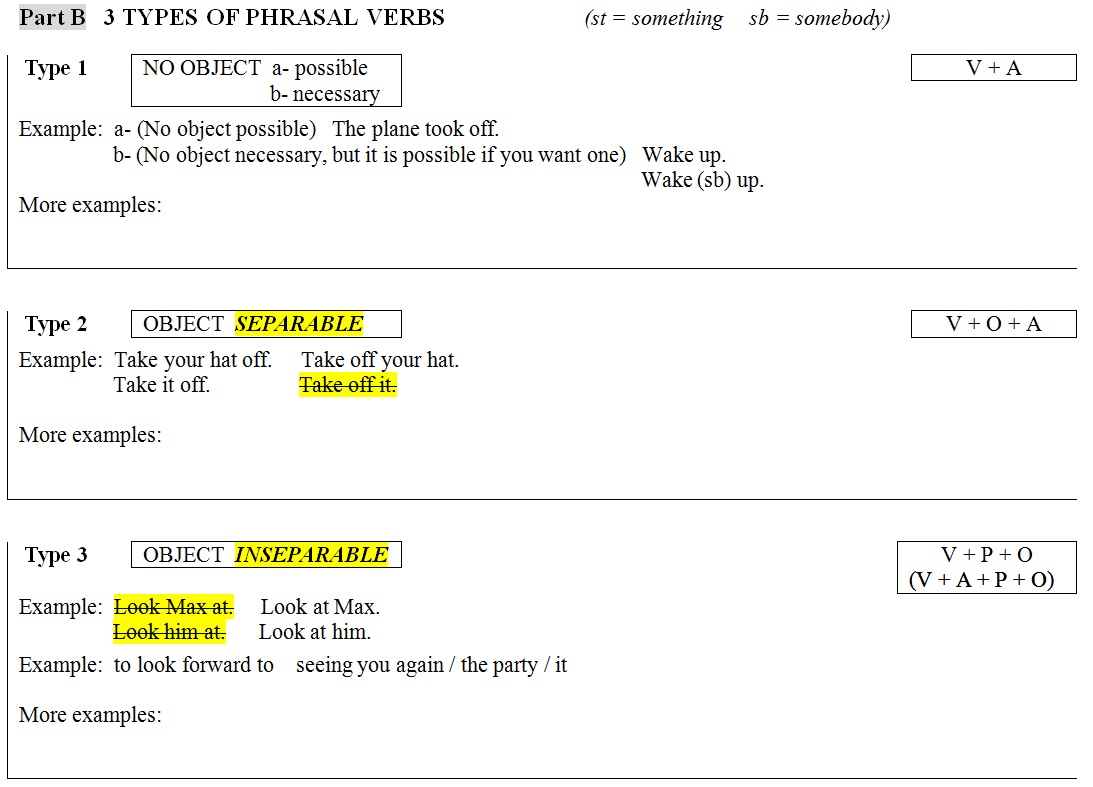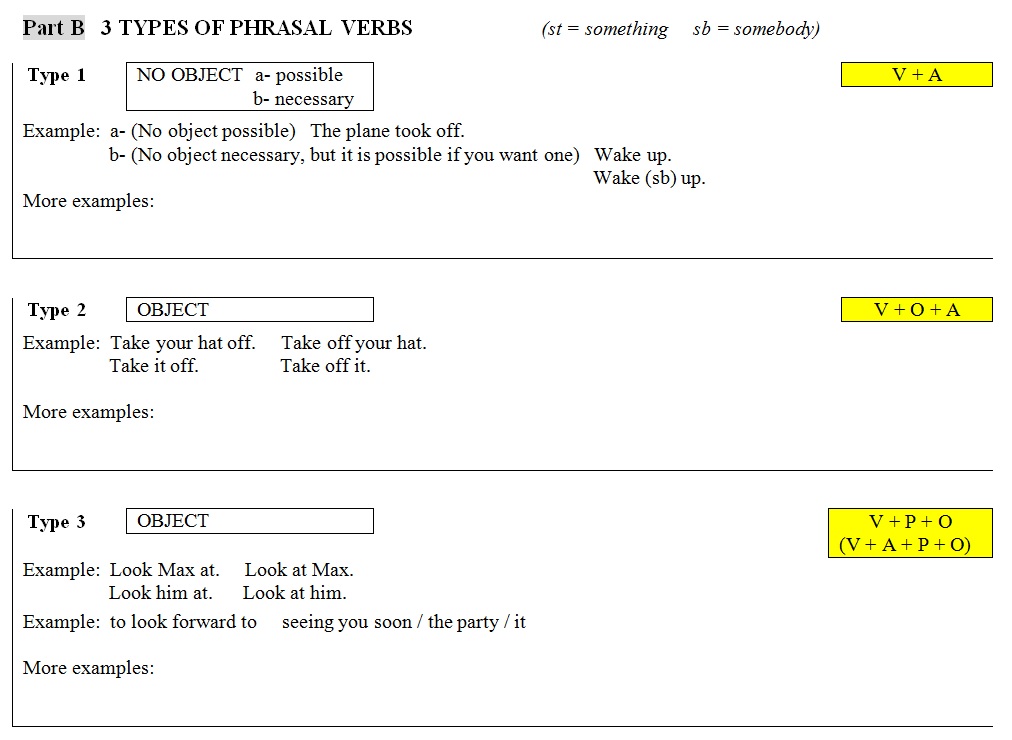Main Course 3-1 / PHRASAL VERBS / Day 1 of 3
GENERAL AIMS
- To increase students’ understanding of what a phrasal verb is and how it works
- To have students become accustomed to standard approaches of how phrasal verbs are viewed and categorized according to their function and properties
- To have students apply those ideas of categorizing phrasal verbs according to how they are used with new examples
- To increase the students’ confidence in their use of phrasal verbs
STEP SUMMARY
|
A |
Introduction |
What is a phrasal verb? |
|
|
B |
3 Types |
Categorizing different kinds |
|
|
C |
How you know |
Some grammar behind phrasal verbs |
|
|
D |
Apply |
Students put knowledge into practice |
RECOMMENDED LEVELS
Intermediate up
ACTIVITY TIME
35+ minutes
MATERIALS
- Board, screen or flip chart
- Handouts for class:
HO1 3 Types worksheet
HO2 low level homework
HO3 higher level homework
SPECIAL NOTES
– Note 1
Quickpage
Class Plan
PART A: INTRO
| A | STEP 1 | TOP OF THE HANDOUT PHRASAL VERBS | ||
| a) | Give the handout (HO 1) to the students and write the title on the board for this lesson: PHRASAL VERBS | |||
| b) | Elicit what a phrasal verb consists of, write the answer on the board, students copy onto their worksheet:
|
|||
| PHRASAL VERB = verb + particle(s) | – adverb | |||
| – preposition | ||||
| A | STEP 2 | (IN) TRANSITIVE VERBS PART A PHRASAL VERBS | ||
| a) | Direct the students to the headings on the handout: TRANSITIVE VERBS and INTRANSITIVE VERBS | |||
| b) | Ask them if they know what an object of a verb is. Elicit or explain:
It’s a noun, which could be a simple noun, a pronoun or a group of words which describe one idea. |
|||
| Ex: She doesn’t like | music. | |||
| it. | ||||
| smoking in bed. | ||||
| It’s something which receives the action of the verb or is modified by it in some way. | ||||
| c) | Look at the examples in the ‘both’ category. Mention that when the verb is intransitive, there is no object for that verb. One way to see if a verb is intransitive is to try it as a simple imperative. Ex: Sing.
The verbs in this group can also take an object, so they can also be considered transitive when using an object. |
|||
| d) | Referring to the row of 8 verbs below the boxes, elicit one example each for the Transitive & Intransitive groups. Tell the students to write them in the appropriate box. | |||
| e) | Students individually look at the remaining six verbs and place them as they did the first two. | |||
| f) | Go over the answers. | |||
PART B: 3 TYPES OF PHRASAL VERBS
| B | STEP 1 | TYPE 1 3 TYPES PHRASAL VERBS | ||||||
| a) | If it hasn’t come up yet, tell the students that ‘st’ refers to something and ‘sb’ refers to somebody. | |||||||
| b) | All the verbs in the first group of Part B are to be considered Type 1 phrasal verbs. This means that there is no object connected with the verb. | |||||||
| c) | Note that there are 2 interpretations of NO OBJECT which lead to 2 subgroups: | |||||||
| a – NO OBJECT is possible | ||||||||
| b – NO OBJECT is necessary but it is an option when appropriate for the situation. These verbs are still considered intransitive but can change into a transitive group if such an object is required to complete the idea, not dissimilar to the BOTH group looked at briefly in Part A. | ||||||||
| d) | Look at example ‘a’ for NO OBJECT is possible: The plane took off. | |||||||
| Elicit what the subject of the sentence is. | (the plane) | |||||||
| Elicit what the verb is. | (take off) | |||||||
| Elicit the meaning of the phrasal verb. | (to leave the ground, to depart) | |||||||
| What is the object of the verb? | (There isn’t any.) | |||||||
| It is not possible for any verbs in this subgroup to have an object. | ||||||||
| e) | Look at example ‘b’ for NO OBJECT is necessary: Wake up. | |||||||
| Like the verbs in the previous subgroup, the meaning and the grammar of the sentence is perfectly correct with no object placed after the verb. However, sometimes you want to include an object (such as a different reference (ie, noun) than the one creating the action) and verbs in this subgroup have that option.
If a person wants to communicate something using one of these verbs with an object, they have to follow the norms set for a Type 2 or a Type 3 phrasal verb. (More examples will be given later.) |
||||||||
| B | STEP 2 | TYPE 2 3 TYPES PHRASAL VERBS | |
| a) | There are 4 simple sentences provided as examples. Elicit the phrasal verb. (take off) | ||
| b) | Elicit the meaning. (to remove) | ||
| c) | Point out that all the verbs in this group require an object and that it is possible to separate the particle from the principle verb to insert the object between them. TAKE your hat OFF. | ||
| d) | ‘Separate’ is a key word. It is in the verb form. Elicit the adjective form which conveys the meaning ‘to be capable of separation’. (separable) | ||
| e) | Write the word SEPARABLE in the box next to OBJECT and tell the students to do the same. | ||
| f) | Tell the students to look at the 4 example sentences using the phrasal verb take off. One of them is incorrect. Elicit which one. (Take off it.) | ||
| g) | Tell the students to put a big ‘X’ on that sentence. | ||
| h) | All Type 2 phrasal verbs have the capacity to be expressed in the three remaining ways, the ones that are not crossed out. | ||
| If using the complete object (your hat) in the sentence, the object can be inserted between the verb and particle, or follow the phrasal verb (by being placed after it). | |||
| If a pronoun form is being used, it can only be inserted in the centre; it never follows the phrasal verb. | |||
| B | STEP 3 | TYPE 3 3 TYPES PHRASAL VERBS | |
| a) | Elicit the opposite of ‘separable’. (You can give a hint if need: use a prefix.) (inseparable) | ||
| b) | Write the word INSEPARABLE in the box next to OBJECT in the Type 3 section of the worksheet and tell the students to do the same. | ||
| c) | You need an object for all verbs in this group, just like those in the group of Type 2, except how the object is placed is a little different. In the 4 example sentences, two are incorrect. Elicit which ones.
(Look Max at.) (Look him at.) |
||
| d) | These phrasal verbs are inseparable; you cannot separate the particle from the verb to insert the object. The object, either in full form, or in pronoun form, comes after the verb. Ask the students if they know why.
(The answer is in Part C of this lesson plan.) |
||
PART C: HOW TO KNOW
WHICH TYPE A PHRASAL VERB IS
| C | Many of the details explaining how dictionaries present the different forms of phrasal verbs are explained in SPECIAL NOTES 1 which you can refer to by clicking onto the appropriate icon in the Handout Page at the end of this lesson plan. Below is a simplified procedure without those details. |
| C | STEP 1 | V+A V+O+A V+A+P+O HOW TO KNOW PHRASAL VERBS | |||||
| a) | In the right margin of the handout, the students can see 3 boxes with some letters in them. Elicit or tell them what the letters stand for: V = verb A = adverb O = object (of verb) P = preposition | ||||||
| b) | Tell the students that the book publisher Collins uses these symbols in the margins of their dictionaries to indicate which type of phrasal verb they are describing. | ||||||
| V + A | without any ‘O’ means the verb doesn’t take an object, so it is Type 1. | ||||||
| V + O + A | has an ‘O’, so it is transitive, and the complete object has the possibility of being inserted between verb and the adverb, or after it. The pronoun form of the object can only be placed between the verb and adverb. In other words, Type 2. | ||||||
| V + P + O | has an ‘O’ but is placed after the phrasal verb. The object, in its complete form or its pronoun form can only be placed there, never between the verb and preposition. Type 3. | ||||||
| V + A + P + O | as the example above, it has an ‘O’ so an object is required and is placed only after the phrasal verb, in its complete or pronoun forms. It is considered Type 3 as well. | ||||||
| c) | For those phrasal verbs that are intransitive but have the capacity to be used with an object, they can be written as follows: V + (O) + A which would make it a Type 1 phrasal verb but if used with an object, it will become a Type 2. The parenthesis shows the optional use of the object and its location shows which type. There are also phrasal verbs which are originally Type 1 but can become a Type 3 if an object is used. These typically employ the use of a preposition. Ex: get on get on with somebody | ||||||
| C | STEP 2 | ANOTHER SYSTEM HOW TO KNOW PHRASAL VERBS | ||||||||
| a) | There are other dictionaries and other systems in use to identify which kind of phrasal verb you are dealing with. The most common is the following: | |||||||||
| take off | When you see the verb and a particle without any object (st = something and sb = somebody), it is automatically considered Type 1. | |||||||||
| take st off | When you see the object (st or sb) placed between the verb and particle, you know automatically that it is Type 2 and can be expressed in all 3 forms allowed in Type 2:
Take your hat off Take it off Take off your hat |
|||||||||
| look at st/sb | When the word appears in the dictionary with the object following the phrasal verb, it is considered Type 3 and has the two options: | |||||||||
| Look at the birds Look at them | ||||||||||
| look forward to st | The same thing applies if the phrasal verb has two particles: | |||||||||
| Look forward to the party Look forward to it | ||||||||||
| b) | If the phrasal verb is Type 1 but has the option of an object it will be written as follows using this system: | |||||||||
| wake (sb) up | Which means that the Type 1 verb doesn’t need an object, but if one is used, the phrasal verb becomes a Type 2. | |||||||||
| get on (with sb) | This is a Type 1 phrasal verb with the option of becoming a Type 3 if an object is used. | |||||||||
| c) | Tell the students that this system is the most common, found in most dictionaries and student books. (It is also the system used in this website). The classification of ’Types 1, 2 & 3’ is useful in referring to how certain kinds of phrasal verbs can be used, but the idea is for the students to eventually forget the numbers and become accustomed to using such a system as explained above. It gives them more independence, not having to ask the teacher about how to use the phrasal verb. | |||||||||
PART D: TITLE
| D | STEP 1 | MEANING OF EXAMPLES WORKSHEET PRACTICE PHRASAL VERBS | |
| a) | Have the students look at the 12 phrasal verbs in Part C of the worksheet. Elicit or explain the meaning. | ||
| b) | Say each phrasal verb with the intonation of saying an expression, connecting the sounds and have the students repeat after you, thinking of the meaning while saying it. | ||
| D | STEP 2 | CLASSIFYING INTO TYPES WORKSHEET PRACTICE PHRASAL VERBS | |
| a) | Tell the students that they will have to decide which group (Type 1, 2 or 3) the phrasal verbs belong to. You could elicit a couple of examples and the reason why, to get them started. | ||
| b) | Students work individually, using the symbols and where they are placed to guide them. They must find four examples for each type. | ||
| c) | Students check their answers in pairs. | ||
| d) | Go over the answers and address any questions. | ||
| D | STEP 3 | GIVE HOMEWORK NEW WORKSHEET PHRASAL VERBS | ||
| a) | Assign homework for the next class. There are two possible handouts to choose from: | |||
| 1 – If it is a lower level class (intermediate or lower), choose HO 2 | ||||
| 2 – A higher level group can do HO 3 | ||||
| b) | After giving out the appropriate worksheet for homework, go over any vocabulary questions. | |||
| c) | -optional additional homework: If you like, you could ask the students to put the phrasal verbs from HO2 or HO3 into sentences. They could hand them in to you, or you could quickly look them over, if you don’t have too many students. | |||









